Technical Solutions of Forest Machine Hybridization
Abstract
:1. Introduction
2. Concepts of Hybridization
2.1. Electro-Hybrids
2.2. Hydraulic Hybrids
2.3. Electro-Hydraulic Hybrids
3. Discussion
4. Conclusions
Author Contributions
Funding
Institutional Review Board Statement
Informed Consent Statement
Data Availability Statement
Acknowledgments
Conflicts of Interest
References
- Solouk, A.; Shakiba-Herfeh, M.; Arora, J.; Shahbakhti, M. Fuel consumption assessment of an electrified powertrain with a multi-mode high-efficiency engine in various levels of hybridization. Energy Convers. Manag. 2018, 155, 100–115. [Google Scholar] [CrossRef]
- Klvač, R.; Ward, S.; Owende, P.M.O.; Lyons, J. Energy Audit of wood harvesting systems. Scand. J. For. Res. 2003, 18, 176–183. [Google Scholar] [CrossRef]
- Sellgren, U. Engineerimg Education for Industrial Innovation. Available online: https://www.researchgate.net/publication/266291963_ENGINEERING_EDUCATION_FOR_INDUSTRIAL_INNOVATION (accessed on 10 January 2021).
- Johnsen, T. Logset 12H GTE Hybrid-Electric Harvester. Available online: https://www.forestry.com/editorial/logset-12h-gte-electric-hybrid-harvester/ (accessed on 28 February 2021).
- Lin, T.; Wang, Q. Hydraulic accumulator-motor-generator energy regeneration system for a hybrid hydraulic excavator. Chin. J. Mech. Eng. 2012, 25, 1121–1129. [Google Scholar] [CrossRef]
- Einola, K. Prestudy of a Power Management of a Cut-To-Length Forest Harvester with a Hydraulic Hybrid System. In Proceedings of the 13th Scandinavian International Conference on Fluid Power, Linköping, Sweden, 3–5 June 2013; pp. 71–83. [Google Scholar]
- Roubíček, O. Příručka techniky, volby a užití vybraných druhů. In Elektrické Motory a Pohony, 1st ed.; BEN-technická literatura: Prague, Czech Republic, 2004; pp. 1–191. [Google Scholar]
- Kůs, V. Elektrické Pohony a Výkonová Elektronika, 2nd ed.; University of West Bohemia in Pilsen: Pilsen, Czech Republic, 2016; pp. 1–181. [Google Scholar]
- Ishida, K.; Higurashi, M. Hybrid wheel loaders incorporating power electronics. Hitachi Rev. 2015, 64, 398–402. [Google Scholar]
- Procházka, P.; Pazdera, I.; Cipín, R. Hybrid Tree Harvester Machine with Battery Powered Hydro-electric Drive. ECS Trans. 2019, 95, 349–354. [Google Scholar] [CrossRef]
- Tkotz, K. Příručka pro Elektrotechnika, 2nd ed.; Handlíř, J., Translator; Verlag Europa-Lehrmittel: Haan-Gruiten, Germany, 2014; pp. 1–624. [Google Scholar]
- Blahovec, A. Elektrotechnika III: (Příklady a Ulohy), 6th ed.; Informatorium: Prague, Czech Republic, 2015; pp. 1–291. [Google Scholar]
- Sani, A.; Siahaan, S.; Mubarakah, N.; Suherman, S. Supercapacitor performance evaluation in replacing battery based on charging and discharging current characteristics. IOP Conf. Series: Mater. Sci. Eng. 2018, 309, 1–6. [Google Scholar] [CrossRef]
- Hromádko, J. Speciální Spalovací Motory a Alternativní Pohony: Komplexní Přehled Problematiky pro Všechny Typy Technických Automobilních Škol, 1st ed.; Grada Publishing a.s.: Prague, Czech Republic, 2012; pp. 1–160. [Google Scholar]
- Lin, T.; Wang, Q.; Hu, B.; Gong, W. Development of hybrid powered hydraulic construction machinery. Autom. Constr. 2010, 19, 11–19. [Google Scholar] [CrossRef]
- Lajunen, A.; Suomela, J.; Pippuri, J.; Tammi, K.; Lehmuspelto, T.; Sainio, P. Electric and Hybrid Electric Non-Road Mobile Machinery–Present Situation and Future Trends. World Electr. Veh. J. 2016, 8, 172–183. [Google Scholar] [CrossRef] [Green Version]
- Logset Oy. Logset 12H GTE Hybrid. Available online: https://www.logset.com/harvesters/logset-12h-gte-hybrid (accessed on 3 January 2021).
- Anon. The Most Productive Hybrid Forest Harvester in the World. Available online: https://www.electrificationstory.com/logset-hybrid-forest-harvester/ (accessed on 22 March 2021).
- Sainio, P.; Minav, T.; Lajunen, A.; Tammi, K.; Laurila, L.; Pyrhönen, J.; Pippuri, J.; Kukkonen, S. Technology Road Map for Hybrid and Electrical Drivetrain of Non-Road Mobile Machinery. Available online: https://docplayer.net/48217321-Technology-road-map-for-hybrid-and-electrical-drivetrain-of-non-road-mobile-machinery.html/ (accessed on 15 April 2021).
- Kühmaier, M.; Harrill, H.; Ghaffariyan, M.R.; Hofer, M.; Stampfer, K.; Brown, M.; Visser, R. Using Conjoint Analyses to Improve Cable Yarder Design Characteristics: An Austrian Yarder Case Study to Advance Cost-Effective Extraction. Forests 2019, 10, 165. [Google Scholar] [CrossRef] [Green Version]
- Lin, T.; Huang, W.; Ren, H.; Fu, A.; Liu, Q. New compound energy regeneration system and control strategy for hybrid hydraulic excavators. Autom. Constr. 2016, 68, 11–20. [Google Scholar] [CrossRef]
- Stodart, N. El-forest hybrid forwarder. For. J. 2010, 10, 20–21. [Google Scholar]
- Edlund, J.; Bergeten, U.; Lögren, B. Effects of two different forwarder steering and transmission drive systems on rut dimensions. J. Terramechanics 2012, 49, 291–297. [Google Scholar] [CrossRef]
- Rong-feng, S.; Xiaozhen, Z.; Chengjun, Z. Study on Drive System of Hybrid Tree Harvester. Sci. World J. 2017, 1–7. [Google Scholar] [CrossRef] [Green Version]
- Zemánek, T.; Neruda, J.; Ulrich, R.; Vítek, O.; Procházka, P. Operational evaluation of a timber trailer with the hybrid drive. In Proceedings of the 52nd International Symposium on Forestry Mechanization, Sopron, Hungary, 6–9 October 2019; pp. 162–171. [Google Scholar]
- Laitila, J.; Prinz, R.; Routa, J.; Kokko, K.; Kaksonen, P.; Suutarien, J.; Eliasson, L. Prototype of Hybrid Technology Chipper-D4.6. Available online: https://www.luke.fi/wp-content/uploads/2016/03/D-4.6-Demoreport-hybrid-chipper.pdf (accessed on 15 April 2021).
- Bansal, R.K. A Textbook of Fluid Mechanics and Hydraulic Machines, 9th ed.; Laxmi Publications Ltd.: New Delhi, India, 2005; pp. 1041–1070. [Google Scholar]
- Pavlok, B.; Hružík, L.; Bova, M. Hydraulická Zařízení Strojů, 1st ed.; VSB-Technical University of Ostrava: Ostrava, Czech Republic, 2007; pp. 1–116. [Google Scholar]
- Gangwar, G.K.; Tiwari, M.; Singh, R.B.; Dasgupta, K. Study of different type of hydraulic accumulators, their characteristics and applications. Int. J. Res. Aeron. Mech. Eng. 2014, 2, 56–63. [Google Scholar]
- Heikkilä, M. Energy Efficient Boom Actuation Using a Digital Hydraulic Power Management System. Ph.D. Thesis, Tampere University of Technology, Tampere, Finland, June 2016. [Google Scholar]
- Linjama, M.; Huova, M.; Tammisto, J.; Heikkilä, M.; Tikkanen, S.; Kajaste, J.; Paloniitty, M.; Pietola, M. Hydraulic hybrid working machines project-lessons learned. In Proceedings of the 16th Scandinavian International Conference on Fluid Power (SICFP 2019), Tampere, Finland, 22–24 May 2019; pp. 423–437. [Google Scholar]
- Pivoňka, J. Příručka Hydraulických Pohonů, 1st ed.; SNTL: Prague, Czech Republic, 1969; pp. 1–478. [Google Scholar]
- Erkkilä, M.; Bauer, F.; Feld, D. Universal Energy Storage and Recovery System–A Novel Approach for Hydraulic Hybrid. In Proceedings of the 13th Scandinavian International Conference on Fluid Power, Linköping, Sweden, 3–5 June 2013; pp. 45–52. [Google Scholar]
- Hippalgaonkar, R.; Ivantysynova, M. A Series-Parallel Hydraulic Hybrid Mini-excavator with Displacement Controlled Actuator. In Proceedings of the 13th Scandinavian International Conference on Fluid Power, Linköping, Sweden, 3–5 June 2013; pp. 31–42. [Google Scholar]
- Amrhein, J.; Neumann, U. PRB–regeneration of potential energy while boom-down. In Proceedings of the 8th International Fluid Power Conference, Dresden, Germany, 26–28 March 2012; pp. 63–71. [Google Scholar]
- Einola, K.; Kivi, A. First experimental results of a hydraulic hybrid concept system for a cut-to-length forest harvester. In Proceedings of the 14th Scandinavian International Conference on Fluid Power, Tampere, Finland, 20–22 May 2015; pp. 52–64. [Google Scholar]
- Bosch Rexroth AG. Hydraulic Flywheel HFW. Available online: https://www.boschrexroth.com/en/xc/products/product-groups/mobile (accessed on 10 January 2021).
- Vukovic, M.; Leifeld, R.; Murrenhoff, H. Reducing Fuel Consumption in Hydraulic Excavators—A Comprehensive Analysis. Energies 2017, 10, 687. [Google Scholar] [CrossRef] [Green Version]
- Huova, M.; Aalto, A.; Linjama, M.; Huntala, K.; Lantela, T.; Pietola, M. Digital hydraulic multipressure actuator–the concept, simulation study and first experimental results. Int. J. Fluid Power 2017, 18, 141–152. [Google Scholar] [CrossRef] [Green Version]
- Anon. FORWARDER2020. Available online: https://www.forwarder2020-project.eu/downloads-links/ (accessed on 15 April 2021).
- Hohenlohe, F. Phlegmatisierung als Tugend in der Mobilhydraulik Das Energiespeichersystem des Kranvollernters HSM 405H2. In Hybridantriebe für Mobile Arbeitsmaschinen, 1st ed.; KIT Scientific Publishing: Karlsruhe, Germany, 2011; pp. 151–162. [Google Scholar]
- Al-Thyabat, S.; Nakamura, T.; Shibata, E.; Iizuka, A. Adaptation of minerals processing operations for lithium-ion (LiBs) and nickel metal hydride (NiMH) batteries recycling: Critical review. Miner. Eng. 2013, 45, 4–17. [Google Scholar] [CrossRef]
- Ruffino, B.; Zanetti, M.; Marini, P. A mechanical pretreatment process for the valorization of useful fractions from spent batteries. Resour. Conserv. Recycl. 2013, 55, 309–315. [Google Scholar] [CrossRef]
- Dyatkin, B.; Presser, V.; Heon, M.; Lukatskaya, M.R.; Beidaghi, M.; Gogotsi, Y. Development of a green supercapacitor composed entirely of environmentally friendly materials. ChemSusChem 2013, 6, 2269–2280. [Google Scholar] [CrossRef]
- Propp, K.; Marinescu, M.; Auger, D.J.; O’Neill, L.; Fotouhi, A.; Somasundaram, K.; Offer, G.J.; Minton, G.; Longo, S.; Wild, M.; et al. Multi-temperature state-dependent equivalent circuit discharge model for lithium-sulfur batteries. J. Power Sources 2016, 328, 289–299. [Google Scholar] [CrossRef] [Green Version]
- Huang, S.; Zhu, X.; Sarkar, S.; Zhao, Y. Challenges and opportunities for supercapacitors. APL Mater. 2019, 7, 100901. [Google Scholar] [CrossRef]
- Sedlakova, V.; Sikula, J.; Sedlak, P.; Cech, O.; Urrutia, L. A Simple Analytical Model of Capacity Fading for Lithium–Sulfur Cells. IEEE Trans. Power Electron. 2019, 34, 5779–5786. [Google Scholar] [CrossRef]
- Ayodele, T.R.; Ogunjuyigbe, A.S.O.; Olateju, B.E. Improving battery lifetime and reducing life cycle cost of a PV/battery system using supercapacitor for remote agricultural farm power application. J. Renew. Sustain. Energy 2018, 10, 013503. [Google Scholar] [CrossRef]
- Pozo, B.; Garate, J.I.; Ferreiro, S.; Fernandez, I.; Fernandez de Gorostiza, E. Supercapacitor Electro-Mathematical and Machine Learning Modelling for Low Power Applications. Electronics 2018, 7, 44. [Google Scholar] [CrossRef] [Green Version]
- Payri, F.; Luján, M.J.; Guardiola, C.; Pla, B. A challenging future for the IC engine: New technologies and the control role. Oil Gas Sci. Technol. 2015, 70, 15–30. [Google Scholar] [CrossRef] [Green Version]
- Dahl, J.; Wassén, H.; Santin, O.; Herceg, M.; Lansky, L.; Pekar, J.; Pachner, D. Model Predictive Control of a Diesel Engine with Turbo Compound and Exhaust After-Treatment Constraints. IFAC-PapersOnLine 2018, 51, 349–354. [Google Scholar] [CrossRef]
- Anon. EV Technologies in Working Machinery–Global View. Finpro, 2010. Available online: http://www.finpro.fi/documents/10304/82c1b231-9f5a-44a0-b2e6-b94fbaf53105 (accessed on 16 June 2011).

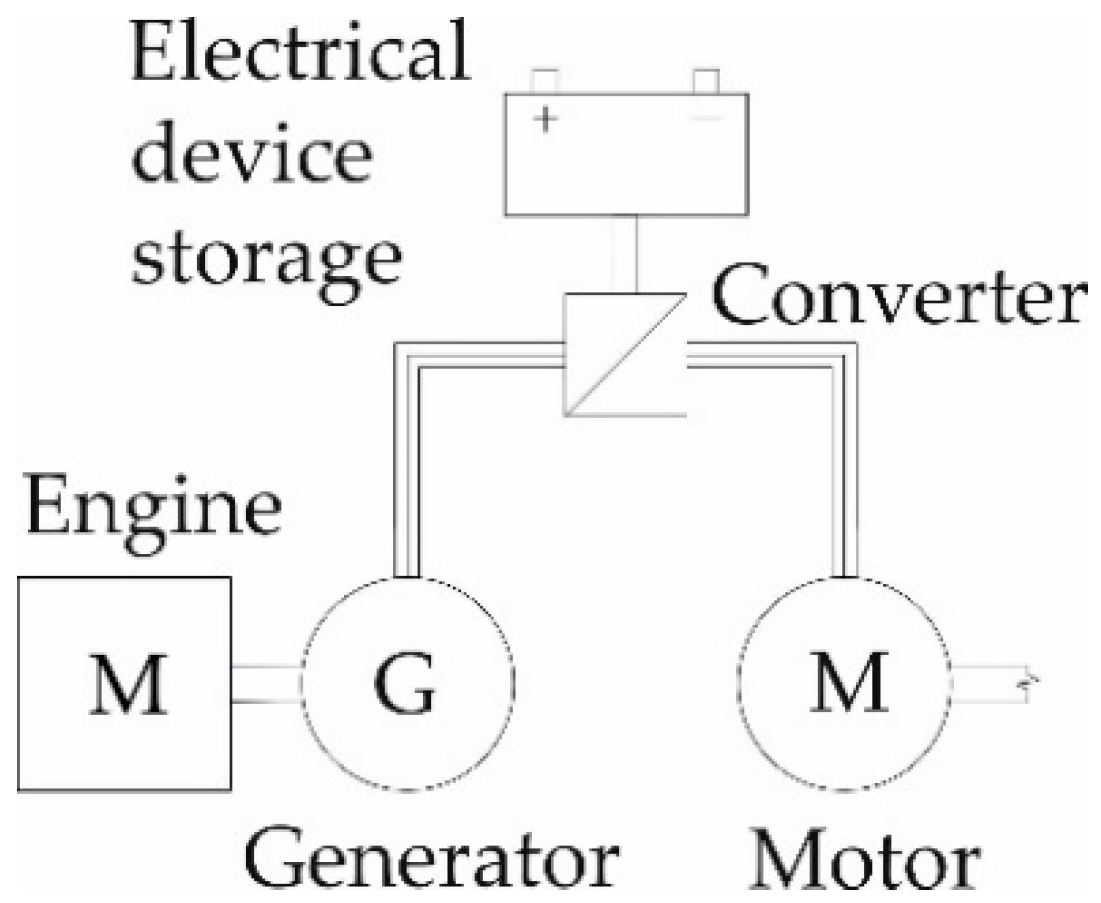
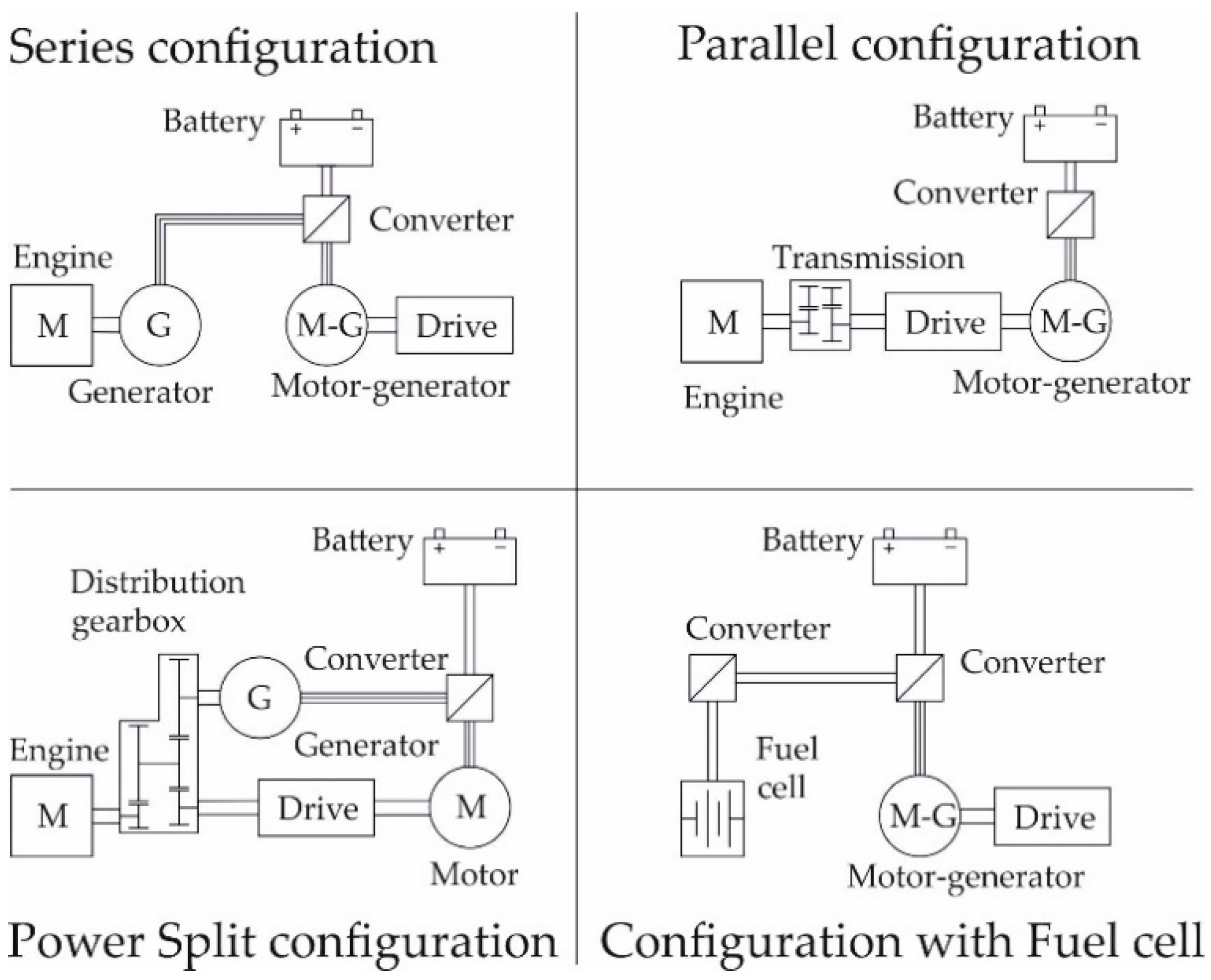
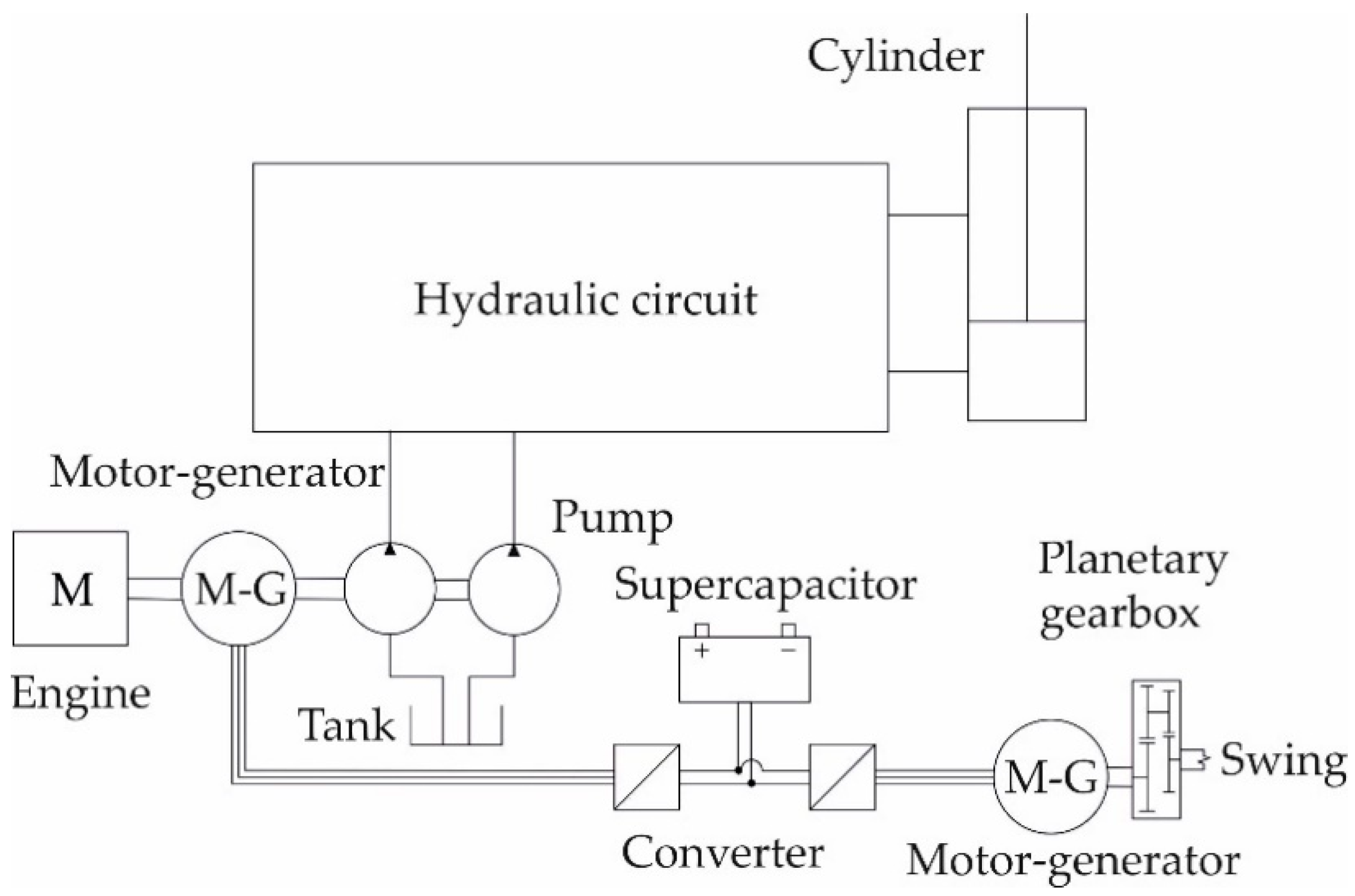
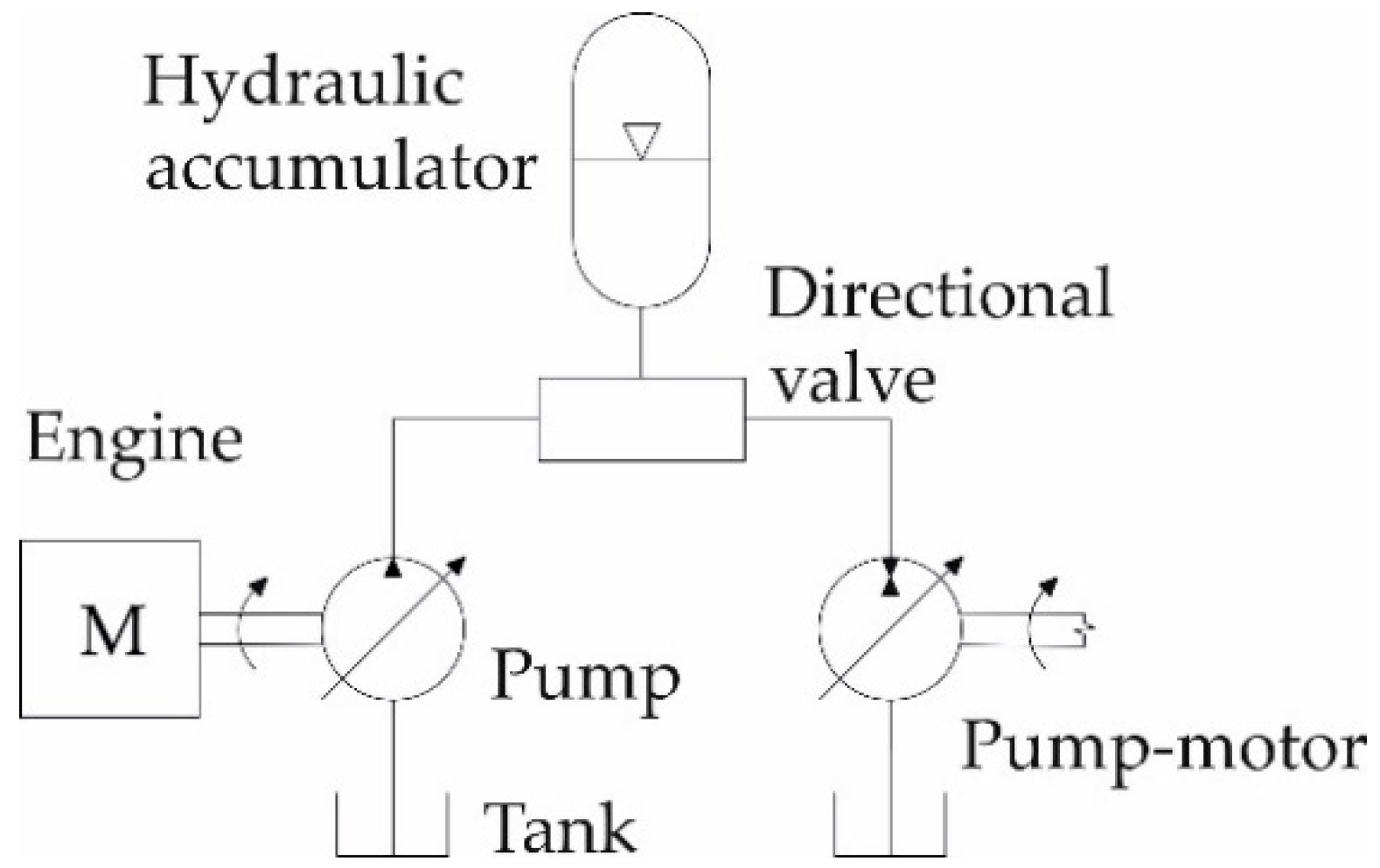
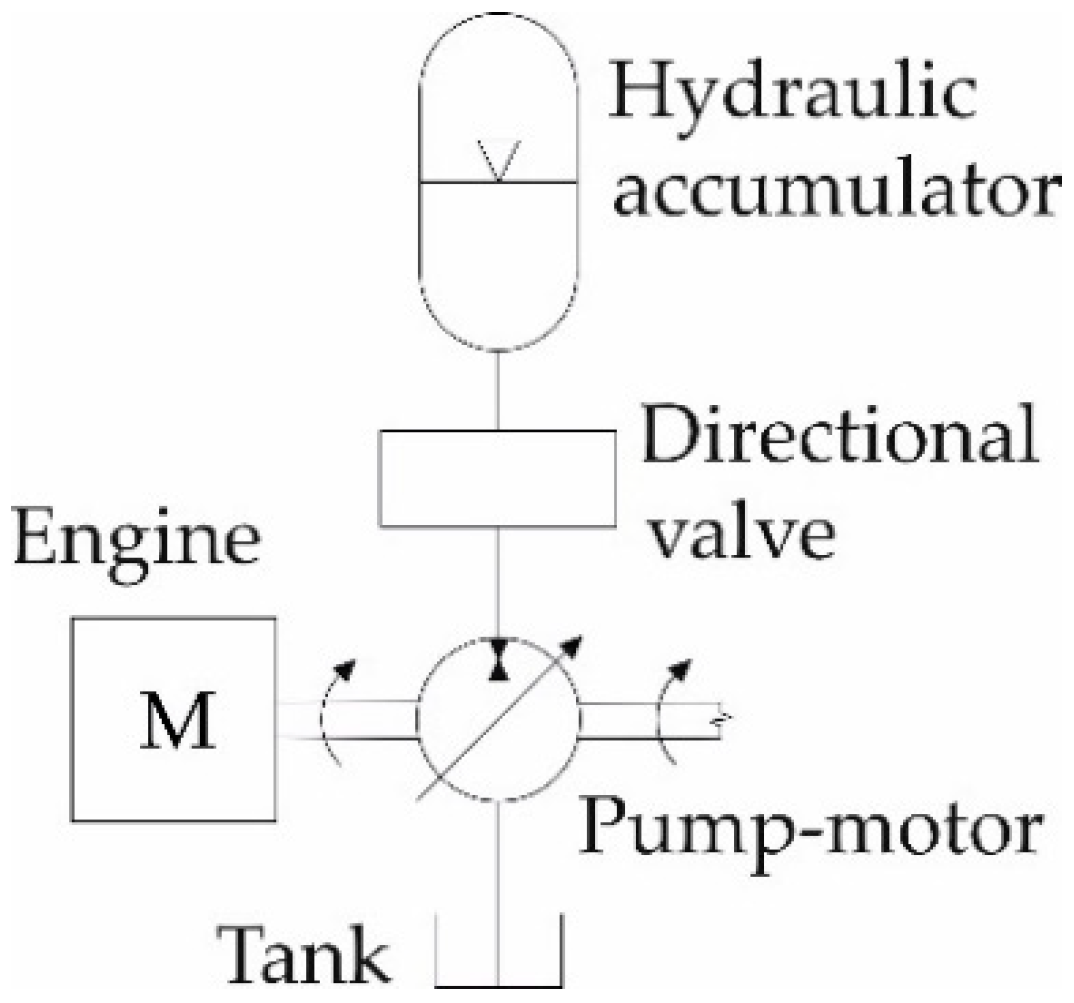
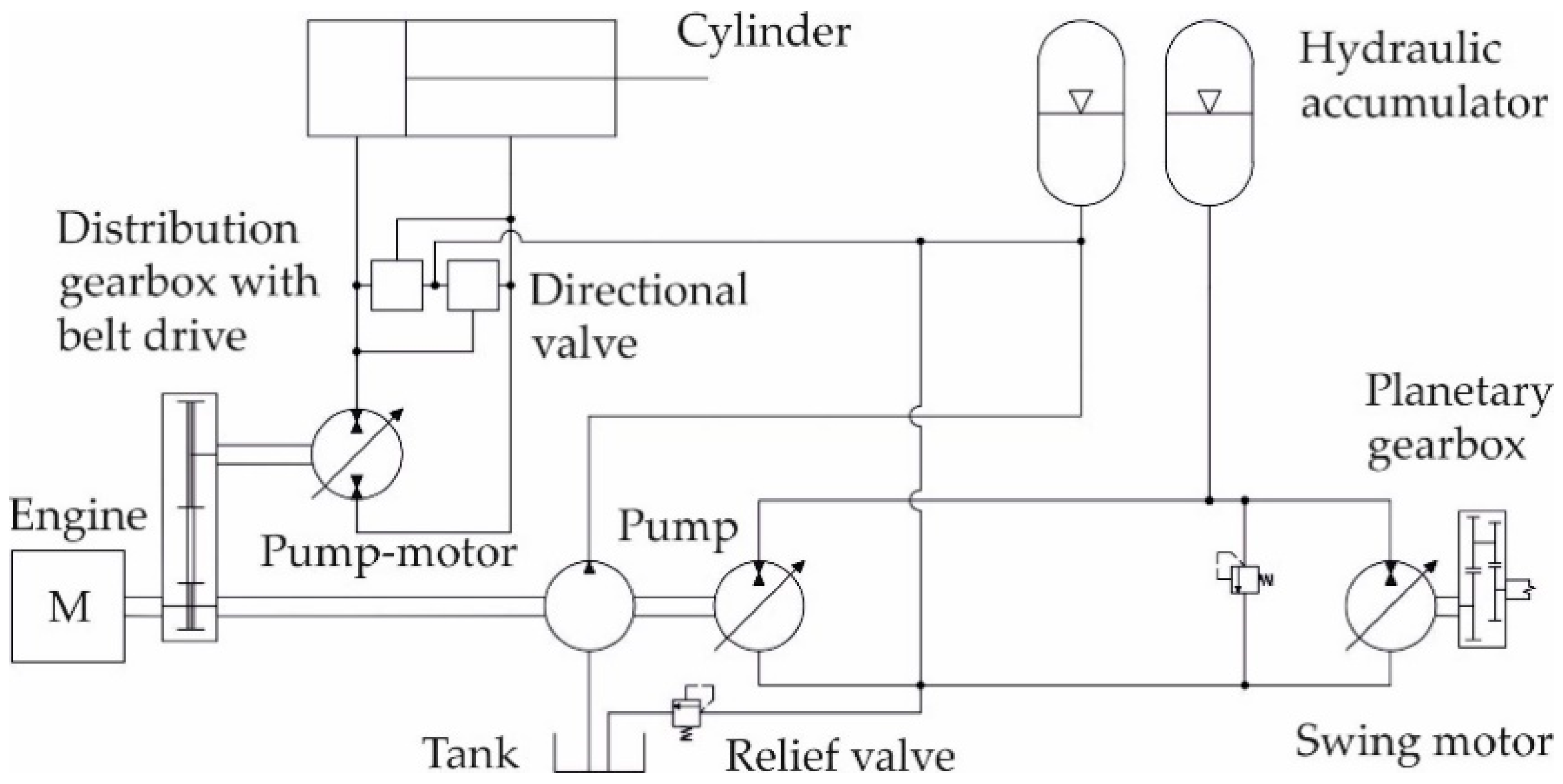
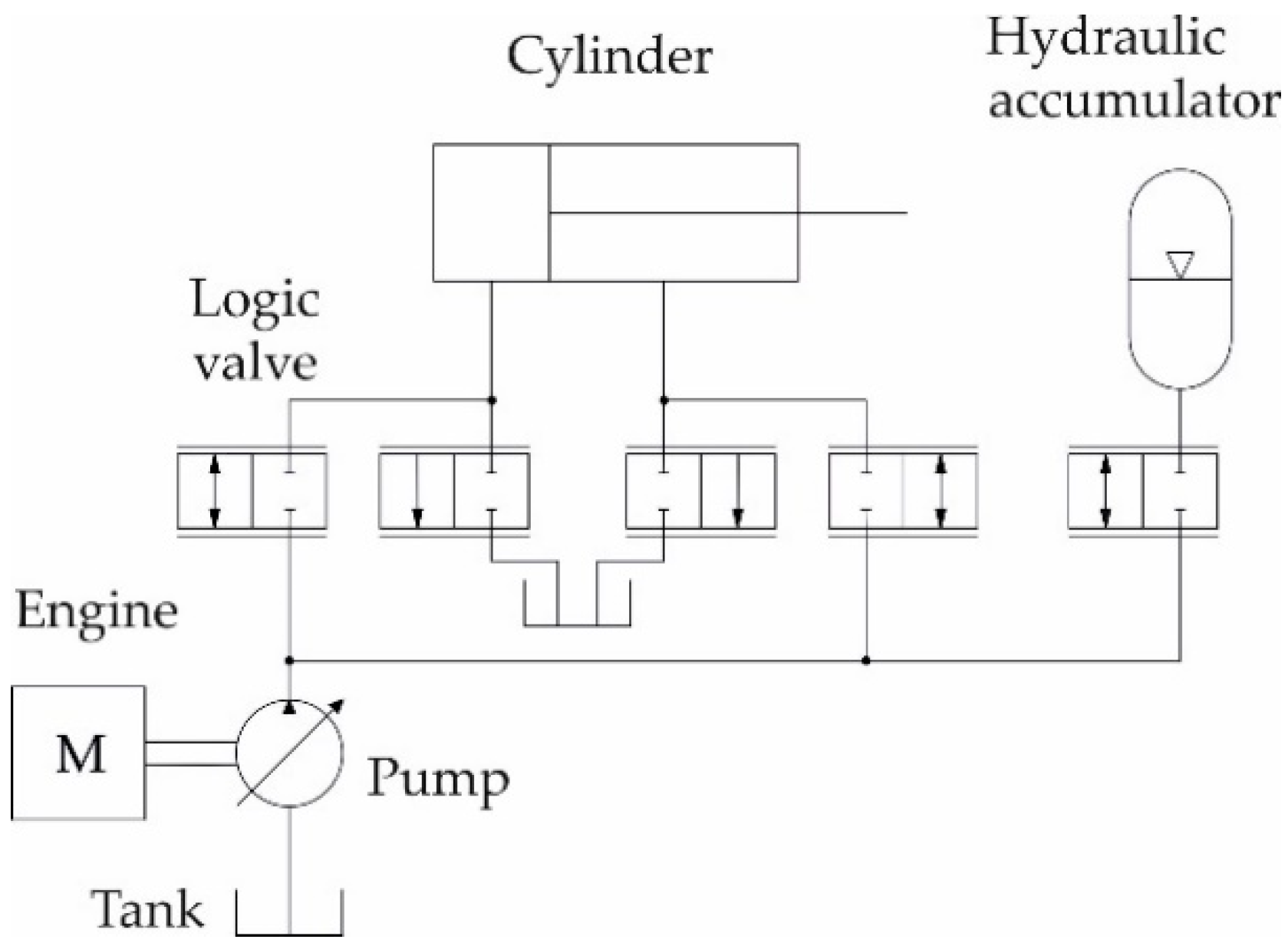
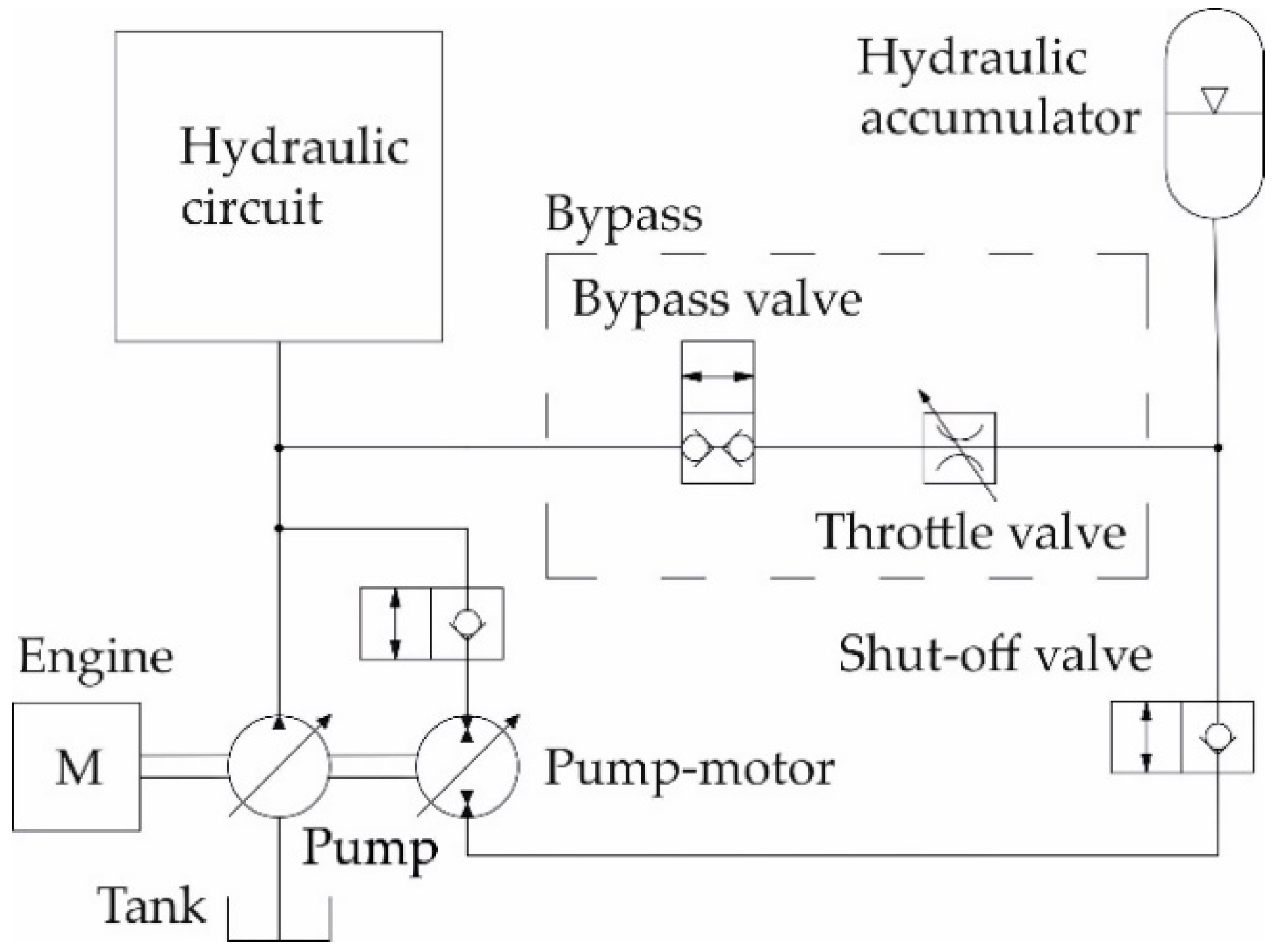
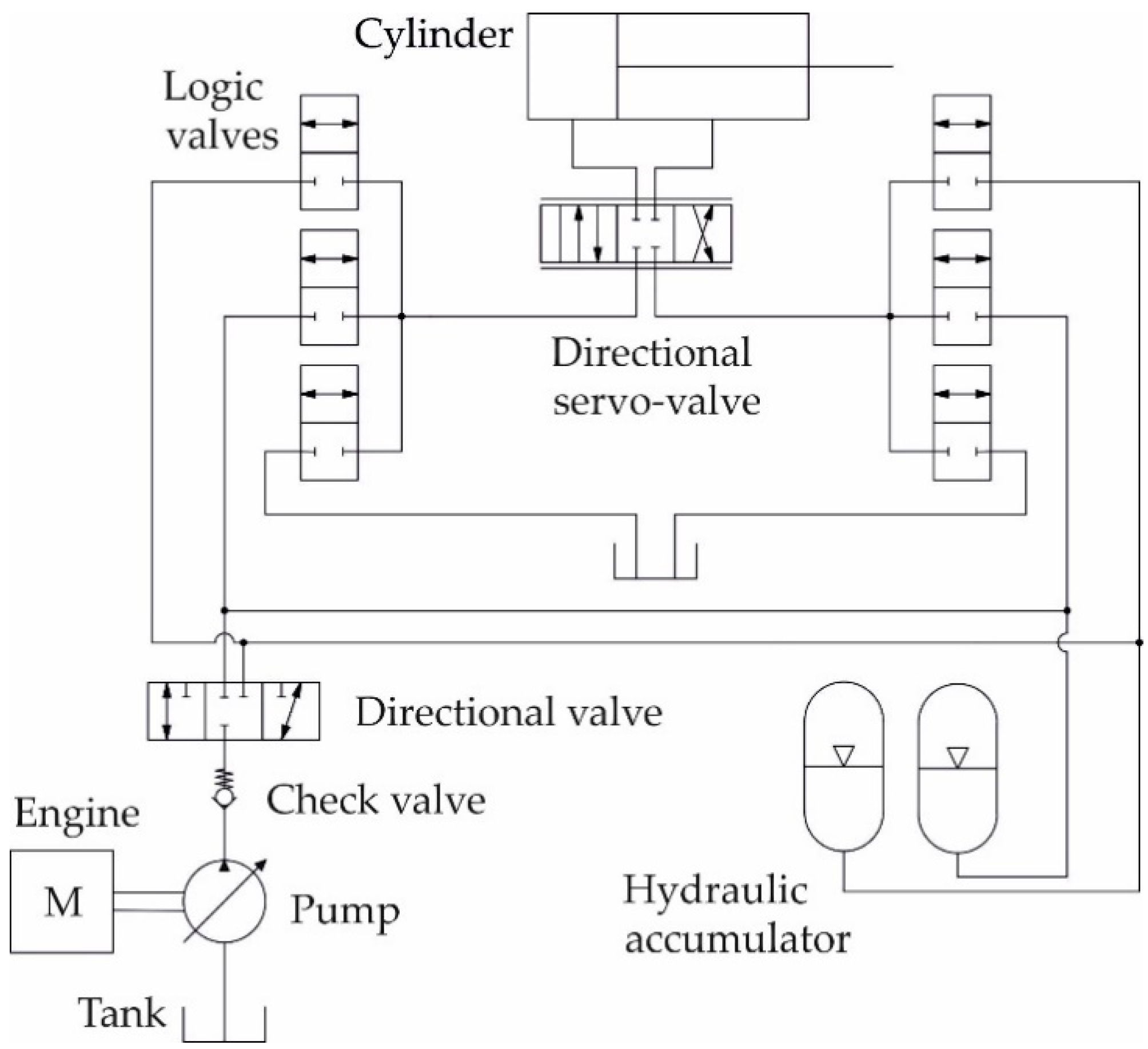
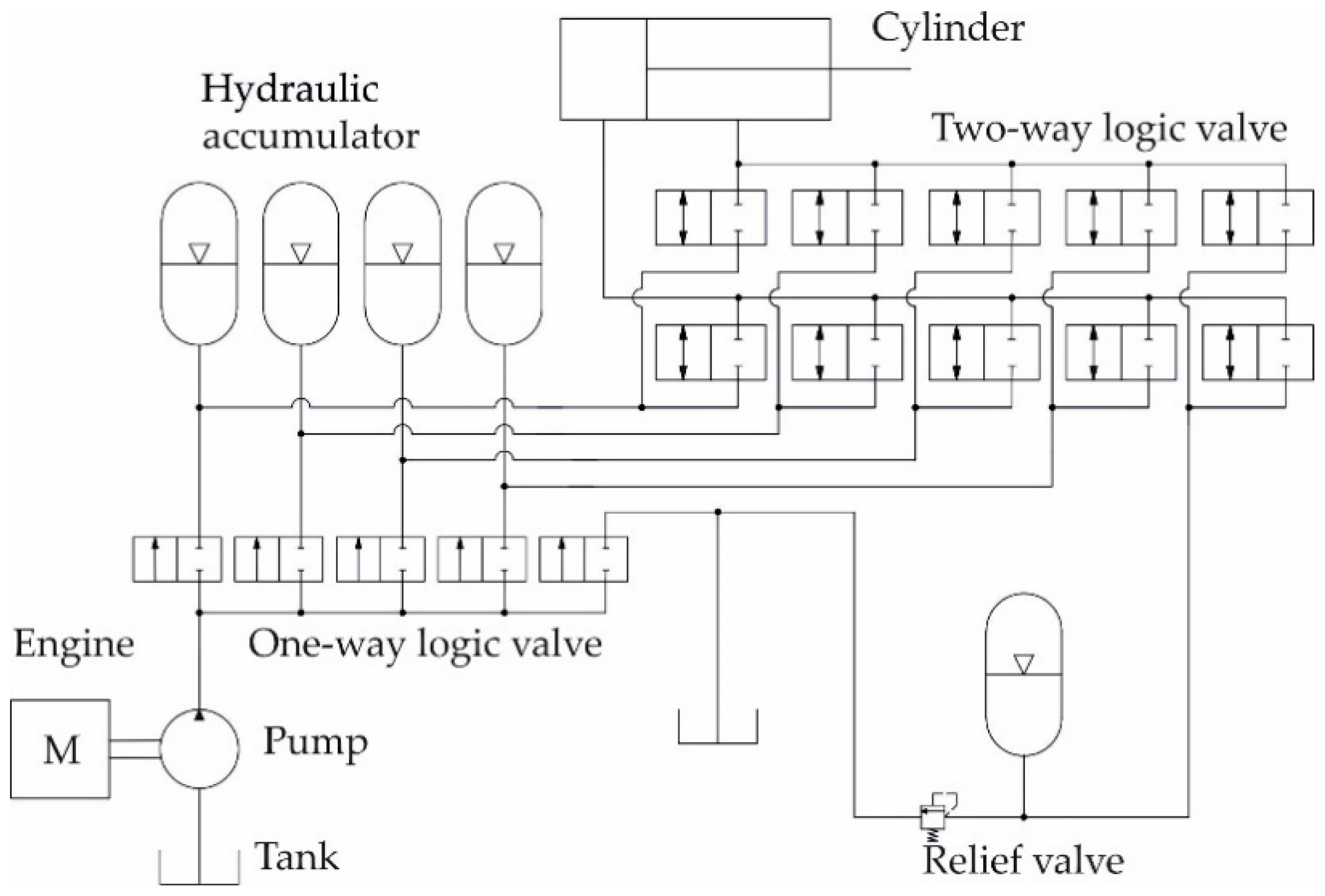

| Type of Hybridization | Machine Type | Fuel Consumption Reduction [%] | CO2 Emission Reduction [%] | Power of Combustion Engine [kW] | Power of Hybrid System [kW] | Accumulator Type/Capacity |
|---|---|---|---|---|---|---|
| Electro-hybrid | 8H GTE Hybrid by Logset Oy (harvester) | up to 25 | 15–30 | 214 | 104 | Supercapacitor/- |
| 12H GTE Hybrid by Logset Oy (harvester) | up to 25 | 15–30 | 214 | 175 | Supercapacitor/- | |
| Harvester by Agama a.s. (harvester) | - | - | - | 23 | Battery/82 Ah, 12 V | |
| 910EH by ProSilva Oyj (harvester) | 40 | - | 60 * | 60 (2 el. motors) | Battery/- | |
| KX 800e by Koller GmBH (excavator based yarder) | - | - | 212 | 800 per winch | Supercapacitor/- | |
| HB365 By Komatsu (excavator) | 20 (average) | 20 (average) | 202 | - | Supercapacitor/- | |
| E70 by New Holland (excavator) | 40 | 40 | 27 ** | 20 | Li-on battery/288 V | |
| ZH210LC by Hitachi Ltd. (excavator) | around 20 | around 20 | 122 | - | Double-layer supercapacitor/- | |
| F14 by Elforest AB (forwarder) | 20–50 | - | 60 | 30 per wheel | Battery/84 V | |
| Harvester by Rong-Feng [24] (harvester) | - | - | 60 | 60 per bogie axle | Li-on battery/105 kW | |
| AGA LV 10 HP by Agama a.s. (wood trailer) | 35 | - | 97 | 18 | Li-on battery/16 kWh | |
| C 860 H by Kesla Oyj (wood chipper) | 20–35 | 20–35 | 160 | - | Supercapacitor/- | |
| Hydraulic hybrid | Caribou S10 by Ponsse Plc. (forwarder) *** | 28 | - | 91 | - | Hydraulic accumulator/20 L |
| Caribou S10 by Ponsse Plc. (forwarder) **** | 36 | - | 91 | - | Two hydraulic accumulator/10 L × 2 | |
| FORWARDER 2020—HSM 208F 12t by HSM forest (forwarder) | 30 | - | 185 | - | Two hydraulic accumulators/- | |
| HSM 405H2 by HSM forest (harvester) | 20 | - | 205 | 90 | Hydraulic accumulator/60 L | |
| Ergo by Ponsse Plc. (harvester) | - | - | 210 | 71 | Hydraulic accumulator/50 L |
| Strengths | Weaknesses |
|---|---|
| Lower fuel consumption Better ergonomics (less noise, vibration, and exhaust emission) Smooth variable continuous power to wheels, drums, hydraulic pump, etc. Environmentally friendly operating (less GHG * and PM ** emissions) Easier operating (automated or remote operation control) Lower physical workload Lighter machines Improved energy storage technology (smaller, lighter batteries, supercapacitors, and hydraulic accumulators with higher energy density) Better efficiency of propulsion motors Shortage of fossil fuels | Purchase price (30–50% higher than conventional) Electrical storage Heavier and more complex systems Low energy density of battery and supercapacitor Overheating of energy storage devices More demanding maintenance Life cycle of battery and supercapacitor Increase in battery and supercapacitor price Shortage of raw materials for battery and supercapacitor production Environmental impacts for production and disposal (recycling) of batteries, supercapacitors Potential hazard of fluid leakage to environment |
Publisher’s Note: MDPI stays neutral with regard to jurisdictional claims in published maps and institutional affiliations. |
© 2021 by the authors. Licensee MDPI, Basel, Switzerland. This article is an open access article distributed under the terms and conditions of the Creative Commons Attribution (CC BY) license (https://creativecommons.org/licenses/by/4.0/).
Share and Cite
Mergl, V.; Pandur, Z.; Klepárník, J.; Kopseak, H.; Bačić, M.; Šušnjar, M. Technical Solutions of Forest Machine Hybridization. Energies 2021, 14, 2793. https://doi.org/10.3390/en14102793
Mergl V, Pandur Z, Klepárník J, Kopseak H, Bačić M, Šušnjar M. Technical Solutions of Forest Machine Hybridization. Energies. 2021; 14(10):2793. https://doi.org/10.3390/en14102793
Chicago/Turabian StyleMergl, Václav, Zdravko Pandur, Jan Klepárník, Hrvoje Kopseak, Marin Bačić, and Marijan Šušnjar. 2021. "Technical Solutions of Forest Machine Hybridization" Energies 14, no. 10: 2793. https://doi.org/10.3390/en14102793






